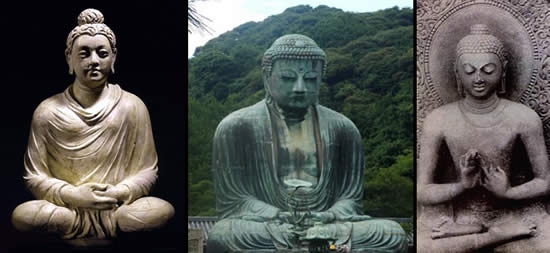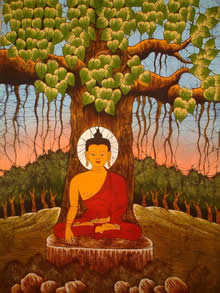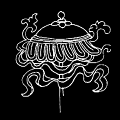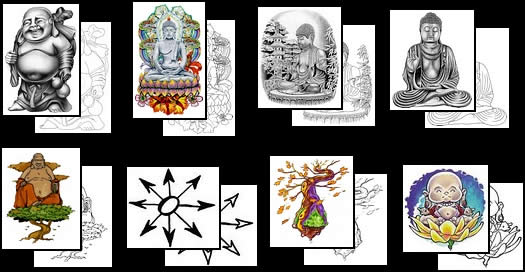|
|
||||||||||||||||||||||||
 |
||||||||||||||||||||||||
|
TATTOO DESIGNS & SYMBOLS - BUDDHA TATTOOS
Tattoo Symbol Index - A B C D E F G H I J K L M N O P Q R S T U V W X Y Z Tattoo designs - B >> Buddha Buddha Tattoo Meanings - Siddhartha Guatama was born a prince, but one of the sages present at his birth predicted greatness that would surpass any regal power. He was sure that Siddhartha would attain 'supreme knowledge', that is, become a Buddha.
Siddhartha left the palace, left his family behind, and became a wandering ascetic and disciple of various Hindu teachers. He even attracted a few disciples himself. But after years of searching and self-denial, he became disillusioned by the path he was on, and gave up the ascetic life. Consequently, his disciples gave up on him, yet Siddartha kept meditating. The year was 528 BC, and the place was under the Bodhi tree in northern India, when Siddhartha experienced his 'awakening'. He woke up to the nature of reality and realized that there is an answer to endless suffering. Gathering his former disciples around him, the new Buddha instructed them in the foundation of what would become Buddhism.
He would call these basics, THE FOUR NOBLE TRUTHS. 1. All Life is Suffering. To live means to suffer. Suffering is a natural part of life and all of us suffer. The cause of this is impermanence. Being born, we must die, and between these two events we experience a never-ending stream of physical and emotional pleasures and pains, of which none can be sustained forever, nor kept forever at bay. Because everything is impermanent, loss is guaranteed, with suffering sure to follow. 2. All Suffering is Caused by Attachments. The origin of suffering is attachment. Attachments are our cravings and expectations, of people and things. Not only do we clamour after transient things, but we are ignorant of how and why the mind is so attached to all these things, thing that must and will surely pass. Attachment begins with desire - desire for physical objects and pleasures, for ideas and virtually anything we can perceive of, including the phantom to which we cling most desperately, the illusion of 'self'. Upon close examination, we find that the 'self' has no substance at all. 3. Suffering Can Be Ended. The cessation of suffering is attainable. The cure is dispassion and equanimity in the face of all fear and desire. Easier said than done-but it can be done - that's the third noble truth. Happiness and contentment are attainable. The state of nirvana brings freedom from suffering in all its forms. But nirvana is a state unfathomable to those who have not attained it. 4. Enlightenment Comes From Following the Eightfold Path. The path to the cessation of suffering is the 'middle way'. Neither excessively hedonistic nor overly ascetic, walking a fine line leads to a gradual purification that brings an end to craving, ignorance, delusions, and ultimately to the end of the cycles of rebirth. The path to enlightenment or, Nirvana.
Right View, or Right Understanding. This means to understand reality as it is, which includes accepting the Four Noble Truths. It means to come to terms with the fact of impermanence of all things, and to understand the law of karma. This isn't just an intellectual exercise, but comes through developing the larger mind Since our view of the world shapes our thoughts, which influence our actions, cultivating 'right view' is an all-important tenet of Buddhism. Right intention. This refers not to any kind of cognitive 'thinking' but to our attitudes and mental energies that affect our actions. This is where 'commitment' comes into play. Do we have the intention to pause and consider the downside of desire? Do we intend to leave a trail of goodwill wherever we go? Do we aim to live a life of harmlessness to others and to develop compassion? We should be committed to ethical and mental self-improvement. We should be committed to overcome our own sufferings and prevent those of our actions that cause suffering in others. Right Speech. Ethical conduct begins with right speech, conscious speech. Unconscious talk cannot help but involve lying, deceit, slander, and personal offense - and at its least offensive, just idle chatter. In other words, speak from the heart and only when necessary. Right Action. The next ethical principle is an admonition not to harm other sentient beings, neither physically, materially, nor sexually. Act compassionately, respect the property of others, and be sexually benign.
1. Do not speak dishonestly. Right Livelihood. We should make our way in the world legally and peacefully. Our wealth should accrue without dealing in weapons or living beings. Buddha listed these things explicitly, and included meat and intoxicants as goods to avoid trading in. In general, abstain from occupations that would violate the principles of right action. Make your living in a manner that does not cause you to compromise your moral or ethical beliefs. Compromises are part of life, but if what you do for a living compromises your integrity, perhaps it is time to make a change. Right Effort, or True Effort. This refers to mental energy or attitude or intention. We've all got this energy, which all too often serves desire, envy and aggression, rather than more wholesome states of mind, like kindness and benevolence. It's all about becoming conscious of mediating between wholesome and unwholesome activities. Right Effort reminds us that we should bring the best of ourselves to everything that we undertake to do. Right Mindfulness. This is the ability to see things as they are, to perceive phenomena without allowing the mind to package and project them beyond recognition. Buddha suggested 'contemplation' as the way to perceive reality without boxing each impression immediately into a preconceived form. Call it 'formless awareness'. Right mindfulness is the perfected faculty of cognition.
What we think and do is central to Buddha's teachings and the path of the practicing Buddhist. Right Mindfulness is at the core of Buddhism. Meditation is 'mindfulness" training, allowing the Buddhist to be present in the now, to BE. Buddha considered right mindfulness to be the key to achieving a state of happiness. Right Concentration, or Right Contemplation. We can all concentrate to some degree, but to gather and focus all our mental faculties onto wholesome thoughts and actions - this is concentration in the service of the Eightfold Path. Meditation is the practice that brings one-pointedness of mind. After a while, this increased ability to concentrate can pervade our whole lives. Right Contemplation is the ability to think deeply and see the world both on the surface and as it really is. This requires the Buddhist to be both focused and thinking deeply. Right Contemplation allows us to stay connected to the world and the people that surround us, but at the same time be able to see our place and life in the grand scheme of the universe. Right Contemplation is about both "getting life" and getting "the big picture". The Buddha set out these principles as a practical guide with the goal of freeing us from attachments and desires, which ultimately leads to our perceiving reality as it is. But the Noble Eightfold Path is not a program to be undertaken sequentially, rather each concept supports all the others. [Revised from www.thebigview.com/buddhism, with thanks.] As a tattoo symbol Buddha may be represented by a literal symbol, such as the statues of Buddha one is familiar with, or by a Lion, a Begging Bowl, a Stupa, an empty Throne, the Bodhi Tree - the tree under which Buddha achieved enlightenment, Buddha's footprints, or an Eight-Spoked Wheel and Deer.
Get inspired by some great images and photos in our Buddha Inspiration Gallery Choose your own Buddha Tattoo Design by the world's top tattoo artists to buy the perfect Buddha design for you. See also: Religious Tattoo Index, Japanese Tattoo Index, Bodhi Tree, Parasol, Buddhist Tattoos, Buddha's Footprint, Conch Shell Tattoos, Begging Bowl, The Empty Throne, Three Jewels, Buddhist Victory Banner, Buddhist Treasure Vase, Buddhist Tattoo Index Tattoo designs - B >> Buddha Tattoo Symbol Index - A B C D E F G H I J K L M N O P Q R S T U V W X Y Z |
|||||||||||||||||||||||
| Celeb Tattoos | Facts & Stats | Designs & Symbols | History | Culture | Links | Tattoo Galleries | Contact | ||||||||||||||||||||||||
|
|
||||||||||||||||||||||||




 How to achieve freedom from suffering, how to attain this state of
nirvana? The Buddha himself described a practical path that devotees
can practice in order to rid themselves of attachment and delusion.
Along with the Four Noble Truths, THE NOBLE EIGHTFOLD PATH
constitutes the essence of Buddhism.
How to achieve freedom from suffering, how to attain this state of
nirvana? The Buddha himself described a practical path that devotees
can practice in order to rid themselves of attachment and delusion.
Along with the Four Noble Truths, THE NOBLE EIGHTFOLD PATH
constitutes the essence of Buddhism. 
 Lotus Flower
Lotus Flower Dharmachakra
Dharmachakra Stupa
Stupa Triratana
Triratana Chattra
Chattra Dhvaja
Dhvaja Deer
Deer Naga
Naga